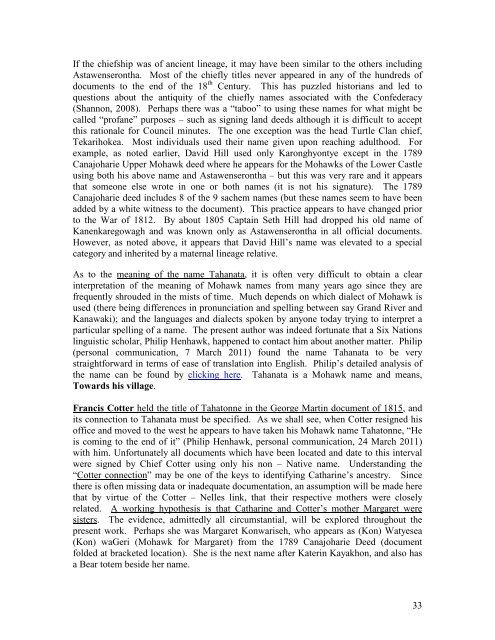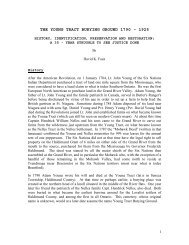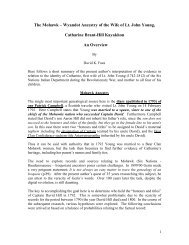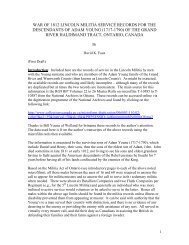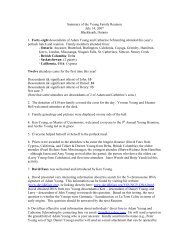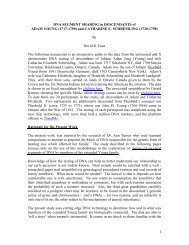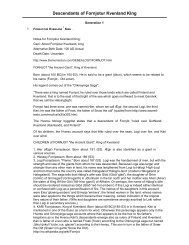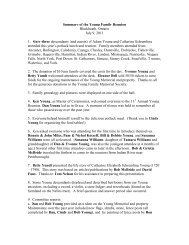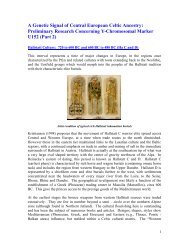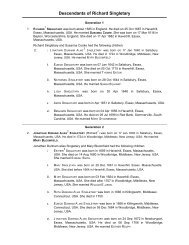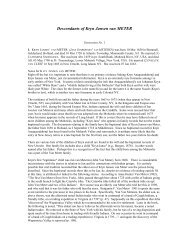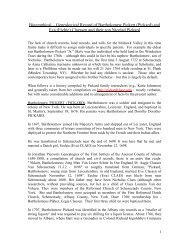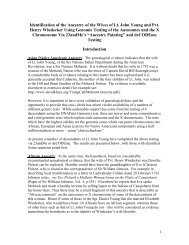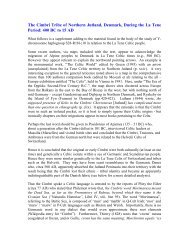Mohawk â Wyandot Ancestry of Lt. John Young's ... - Davidkfaux.org
Mohawk â Wyandot Ancestry of Lt. John Young's ... - Davidkfaux.org
Mohawk â Wyandot Ancestry of Lt. John Young's ... - Davidkfaux.org
- No tags were found...
You also want an ePaper? Increase the reach of your titles
YUMPU automatically turns print PDFs into web optimized ePapers that Google loves.
If the chiefship was <strong>of</strong> ancient lineage, it may have been similar to the others includingAstawenserontha. Most <strong>of</strong> the chiefly titles never appeared in any <strong>of</strong> the hundreds <strong>of</strong>documents to the end <strong>of</strong> the 18 th Century. This has puzzled historians and led toquestions about the antiquity <strong>of</strong> the chiefly names associated with the Confederacy(Shannon, 2008). Perhaps there was a “taboo” to using these names for what might becalled “pr<strong>of</strong>ane” purposes – such as signing land deeds although it is difficult to acceptthis rationale for Council minutes. The one exception was the head Turtle Clan chief,Tekarihokea. Most individuals used their name given upon reaching adulthood. Forexample, as noted earlier, David Hill used only Karonghyontye except in the 1789Canajoharie Upper <strong>Mohawk</strong> deed where he appears for the <strong>Mohawk</strong>s <strong>of</strong> the Lower Castleusing both his above name and Astawenserontha – but this was very rare and it appearsthat someone else wrote in one or both names (it is not his signature). The 1789Canajoharie deed includes 8 <strong>of</strong> the 9 sachem names (but these names seem to have beenadded by a white witness to the document). This practice appears to have changed priorto the War <strong>of</strong> 1812. By about 1805 Captain Seth Hill had dropped his old name <strong>of</strong>Kanenkaregowagh and was known only as Astawenserontha in all <strong>of</strong>ficial documents.However, as noted above, it appears that David Hill’s name was elevated to a specialcategory and inherited by a maternal lineage relative.As to the meaning <strong>of</strong> the name Tahanata, it is <strong>of</strong>ten very difficult to obtain a clearinterpretation <strong>of</strong> the meaning <strong>of</strong> <strong>Mohawk</strong> names from many years ago since they arefrequently shrouded in the mists <strong>of</strong> time. Much depends on which dialect <strong>of</strong> <strong>Mohawk</strong> isused (there being differences in pronunciation and spelling between say Grand River andKanawaki); and the languages and dialects spoken by anyone today trying to interpret aparticular spelling <strong>of</strong> a name. The present author was indeed fortunate that a Six Nationslinguistic scholar, Philip Henhawk, happened to contact him about another matter. Philip(personal communication, 7 March 2011) found the name Tahanata to be verystraightforward in terms <strong>of</strong> ease <strong>of</strong> translation into English. Philip’s detailed analysis <strong>of</strong>the name can be found by clicking here. Tahanata is a <strong>Mohawk</strong> name and means,Towards his village.Francis Cotter held the title <strong>of</strong> Tahatonne in the Ge<strong>org</strong>e Martin document <strong>of</strong> 1815, andits connection to Tahanata must be specified. As we shall see, when Cotter resigned his<strong>of</strong>fice and moved to the west he appears to have taken his <strong>Mohawk</strong> name Tahatonne, “Heis coming to the end <strong>of</strong> it” (Philip Henhawk, personal communication, 24 March 2011)with him. Unfortunately all documents which have been located and date to this intervalwere signed by Chief Cotter using only his non – Native name. Understanding the“Cotter connection” may be one <strong>of</strong> the keys to identifying Catharine’s ancestry. Sincethere is <strong>of</strong>ten missing data or inadequate documentation, an assumption will be made herethat by virtue <strong>of</strong> the Cotter – Nelles link, that their respective mothers were closelyrelated. A working hypothesis is that Catharine and Cotter’s mother Margaret weresisters. The evidence, admittedly all circumstantial, will be explored throughout thepresent work. Perhaps she was Margaret Konwariseh, who appears as (Kon) Watyesea(Kon) waGeri (<strong>Mohawk</strong> for Margaret) from the 1789 Canajoharie Deed (documentfolded at bracketed location). She is the next name after Katerin Kayakhon, and also hasa Bear totem beside her name.33


